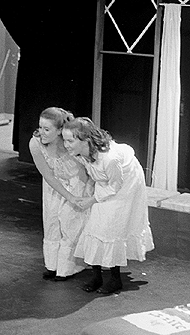








Anyone who has read Christina Rossetti's poem,The Goblin Market, may have trouble imagining it as a musical theater production. It's a good thing playwrights Polly Pen and Peggy Harmon envisioned it this way, and a great thing that the Oberlin Musical Theatre Association decided to bring it to Oberlin.
 The Goblin Market tells the story of two sisters, Laura and Lizzie, who are tempted by the luscious, forbidden fruits sold by goblin men. Laura falls to temptation and Lizzie, in an act of self-sacrifice, must save her from the consequences. Set to music, the story comes alive with all the excitement of a classic fairy tale.
The Goblin Market tells the story of two sisters, Laura and Lizzie, who are tempted by the luscious, forbidden fruits sold by goblin men. Laura falls to temptation and Lizzie, in an act of self-sacrifice, must save her from the consequences. Set to music, the story comes alive with all the excitement of a classic fairy tale.
Rossetti's poem has been the subject of a wide range of critical interpretations since its first appearance in 1859. Acclaimed in that era as a great children's story, it has since been referred to as a parable for everything from the women's civil rights movement to the Christian model of femininity. Indeed, interpretations of the poem vary widely despite Rossetti's claim that she meant nothing profound by it.
Director conservatory senior Alison Ostergaard regards The Goblin Market as an imaginary world created by two little girls as an outlet for the hopes, desires and fears Victorian society forces them to repress. She expresses this theme in almost every aspect of the show, from the setting to costumes and choreography.
The scene is a children's nursery, in the center of which is a huge window where the girls escape into their imaginary goblin world. When we think about the associations we have with windows - air, light, opportunity - it's easy to see why designer college junior Ilisa Stalberg chose to make the window the focus of our attention. Aesthetically pleasing is the illusion of moonlight outside the window, created by the filtering of a bright light through a white curtain.
The costumes reflect the idea that Laura and Lizzie return to their nursery as adults to look back on their childhood fantasies. The show begins with the sisters in fashionable Victorian dresses but they shed this garb as the retrospective journey in time begins and spend most of their little girl roles in nightgowns and bloomers. Ostergaard deals effectively with the conclusion's return to the present by having Laura and Lizzie return to their adult-like clothing. The change in costume creates the illusion of physical leaps in time quite well.
Also noteworthy is Ostergaard's choreography throughout the show. The combination of playful dancing and monstrous gestures used to represent the goblins adds credibility to the ambiance of a childlike world. She manages to use every bit of available space in Little Theater which reinforces the idea of childlike energy and activity.
Certainly, the vivacious performances of college sophomore Levke Haas as Laura and double-degree sophomore Simone Perrin as Lizzie will keep their audience's attention through every minute of the show. These two seem perfectly matched both harmoniously and in character relation. They both keep their energy high from beginning to end and their timing and understanding of one another on stage is so on the mark it's hard to believe they're not really sisters. Haas and Perrin capture the essence of girlhood and sisterhood in the song, "The Sisters," whose refrain is something like "two sisters so lovely and like as like can be." This scene involves a charming hand-in-hand dance and a pouting, stare-down halfway through to determine which sister is the loveliest.
Even if you have no interest in Christina Rossetti or fairy tales, or theater for that matter, you should go to see Goblin Market for its music, courtesy of a piano, violin, cello, percussion and synthesizer quintet. The range of moods from happy to somber to sinister make for interesting changes in music and the use of disturbing ways. Music director Greg Ristow did a great job keeping his quintet not only on cue, but also right in sync with the emotions their parts conveyed. Ristow also made some flavorful instrumentation choices, particularly in regards to goblin voices.
Both Haas's and Perrin's voices get a chance to shine in the show. Perrin's haunting "Sleep, Laura Sleep" will reach the hollows of your bones; her triumphant "Like a Lily" might convince the most liberal of feminists that the old Victorian ideals weren't so bad. Equally thrilling are Haas's near malicious "Some There Are Who Never Venture" and her slithering, frightening descriptions of "cat-like, rat-like and wombat-like" Goblin men.
This production of The Goblin Market may lose some of the sensuality of Rossetti's poem, but it makes up for it with great set, costumes, dancing, music and performances.

Copyright © 1997, The Oberlin Review.
Volume 125, Number 15; February 21, 1997
Contact Review webmaster with suggestions or comments at ocreview@www.oberlin.edu.
Contact Review editorial staff at oreview@oberlin.edu.